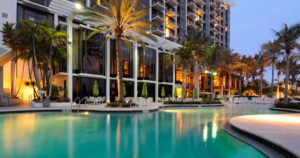How lighting design influences the hospitality industry

<?xml encoding=”utf-8″ ?????????>
Imagine walking into a cosy, rustic cabin nestled in the mountains. As you enter, soft, warm lights greet you, creating shadows that dance on the timber walls.
The subtle, flickering glow of a fireplace makes the space feel intimate, and instantly, the exhaustion from your journey melts away. The thoughtfully placed lighting evokes a sense of comfort that wraps around you like a warm blanket.
The hospitality industry is vast and versatile, encompassing hotels, restaurants, cafes, spas, and other businesses that offer services to travellers and locals alike. These places are not just about providing a bed to sleep in or food to eat; they’re about delivering an experience. Whether it’s a luxurious resort in the Maldives or a charming bistro in Paris, the hospitality industry thrives on making people feel special.
This brings the focus to the ambience, the secret ingredient in the recipe for a perfect hospitality experience. It’s that je ne sais quoi that can make or break a guest’s impression. From the furniture to the aroma, every detail matters. But lighting takes the crown when it comes to setting the mood.
So, what happens when modern innovation steps in? Lighting as a service for hospitality emerges as a game changer. This article explores how lighting design is a crucial component in creating ambience and propelling the success of the hospitality industry. Through clever design, businesses can turn ordinary spaces into memorable experiences, just like the cosy mountain cabin that made you forget all your worries.
The Basics Of Lighting Design
Lighting design is like the invisible hand that guides experiences and emotions. In simple terms, it’s the art and science of illuminating a space. The key components include the light source, direction, intensity, and colour. But it’s not just about ensuring you can see; it’s about crafting a mood, highlighting architecture, and making spaces inviting.
There are several types of lighting that designers juggle. First up, ambient lighting—it’s the base layer that ensures a space is adequately lit. Next, task lighting, which is more focused and helps you do specific activities like reading or cooking. Then, accent lighting steps in to give prominence to certain features, like artwork. Lastly, decorative lighting is the showstopper; think of the stunning chandelier that makes you go, ‘Wow!’
Now, where does technology fit in? It’s pretty much the engine that drives modern lighting design. With advancements in LED technology, spaces can now be illuminated more efficiently and creatively. Features like dimming, colour changing, and smart controls are revolutionising how spaces come to life.
Understanding Lighting-as-a-Service (LaaS)
Lighting as a Service, or LaaS, is an all-in-one package that’s like having a lighting designer, but better. LaaS providers step in and handle everything—from design and installation to maintenance and upgrades.
In the hospitality industry, first impressions are everything. LaaS ensures that businesses always stay on top of their game. Rather than a hotel worrying about changing a burnt-out bulb, the LaaS provider handles it. They can even revamp the lighting setup for a special event or season, ensuring the space is always fresh and appealing.
The perks of LaaS are plenty. Cost-effectiveness is a big one—no upfront costs, just a subscription fee. The flexibility is another; it’s like having an interior designer on speed dial. And customisation means that businesses can tailor the lighting for different events or times of the day. All this, while being sustainable and energy-efficient.
Psychological Effects Of Lighting
Lighting is a mood-maker. It’s like that friend who can either pump you up or calm you down. Bright, cool lighting can make a space feel energetic, while dim, warm lighting can make it feel cosy and intimate.
Colour temperature is the warmth or coolness of the light. It’s a big deal in how people perceive a space. Imagine a romantic restaurant lit with the same lights as a hospital—yikes! The right colour temperature can make a space feel just right.
Lighting Design In Different Hospitality Settings
Crafting a captivating atmosphere requires a tailored approach to lighting design in various hospitality settings.
Hotels
In hotels, lighting design takes on a multifaceted role. The lobby, often the first point of contact for guests, needs to exude warmth and welcome. A blend of ambient and accent lighting can highlight the architecture and create a sense of grandeur.
In contrast, guest rooms require a more personalised touch. Adjustable lighting options allow guests to tailor the room to their preferences, making it a haven away from home.
Meanwhile, in the common areas, such as restaurants or bars within the hotel, attention to detail with lighting is key. For instance, a mix of soft ambient lighting and accent lights focused on tables can create an intimate dining atmosphere in the evening. During the day, allowing natural light to flood the space, complemented by brighter, cooler overhead lights, can make the area feel more open and airy.
As for the bars, using dynamic LED strips that change colour can give a vibrant, energetic vibe during the night, while toned-down warm lights on counters and shelves can create a more relaxed setting for afternoon patrons.
Restaurants And Cafes
In restaurants and cafes, lighting goes beyond visibility; it’s a vital ingredient in the recipe for ambience. For example, a breakfast cafe might utilise natural light to complement the fresh, vibrant interior decor, setting the stage for an energetic start to the day. In contrast, a fine-dining restaurant might opt for lower, warmer lights, paired with well-placed accent lighting to emphasise the elegance and intimacy of the space.
Outdoor seating areas present an opportunity for creative illumination. Strands of fairy lights, lanterns, or LED garden lights can provide a magical setting under the stars. This type of lighting not only creates an inviting atmosphere but also blends the dining experience with nature, giving guests an enriched sensory experience.
In the kitchen and service areas, functionality is key. Bright, cool lights are essential for staff to see clearly while preparing and handling food. Well-positioned task lighting over prep stations can boost efficiency.
In contrast, service areas require a blend of practical and ambient lighting. For instance, a softly lit service station with accent lights showcasing the glassware creates an efficient workspace without breaking the overall atmosphere of the dining area.
Spas And Wellness Centres
The journey to relaxation begins the moment guests step into a spa. In reception and waiting areas, lighting should be calming and inviting. A combination of natural materials and soft ambient lighting can create an oasis of tranquillity.
It’s important to avoid harsh lights, as they can be jarring. A decorative element, such as a tastefully lit water feature, can serve as a focal point that silently whispers to guests that they are entering a sanctuary.
The lighting in treatment rooms should be adjustable to cater to different therapies and preferences. Dimmable lights and the gentle glow of candles can envelop guests in a cocoon of peace. Additionally, specific treatments such as chromotherapy may use coloured lights to enhance the guest’s mood and well-being. The goal is to make the room a canvas, adapting to the unique needs of each guest.
Pools, whether indoor or outdoor, can be transformed into lagoons of luxury with the right lighting. Underwater lights in soft hues, coupled with ambient lights around the pool, can make evening swims magical. Relaxation areas, often outfitted with loungers and daybeds, can benefit from warm, diffused lighting that encourages guests to sit back and let go.
In spas and wellness centres, the lighting design serves not just as illumination but as a silent therapist, aiding in the rejuvenation of the mind, body, and spirit. Through the meticulous arrangement of light, these spaces become havens for those seeking solace and renewal.
Economic Implications Of Lighting Design
Lighting is a major energy consumer in the hospitality industry, but it also offers numerous opportunities for savings. Implementing energy-efficient bulbs such as LEDs can significantly reduce electricity bills. Additionally, incorporating smart systems that adjust lighting based on occupancy or natural light availability can optimise energy use.
Good lighting design doesn’t just save money; it can make money too. By creating an ambience that customers love, they’re more likely to return and recommend the establishment to others. Whether it’s a hotel, restaurant, or spa, a well-lit space can enhance the customer’s experience, translating into positive reviews and, ultimately, increased revenue.
Conclusion
Lighting design is not to be underestimated in the hospitality sector. It plays a pivotal role in setting the atmosphere, enhancing customer experience, and driving sustainability efforts. In an industry where competition is fierce, it’s the finer details like lighting that can set an establishment apart.




